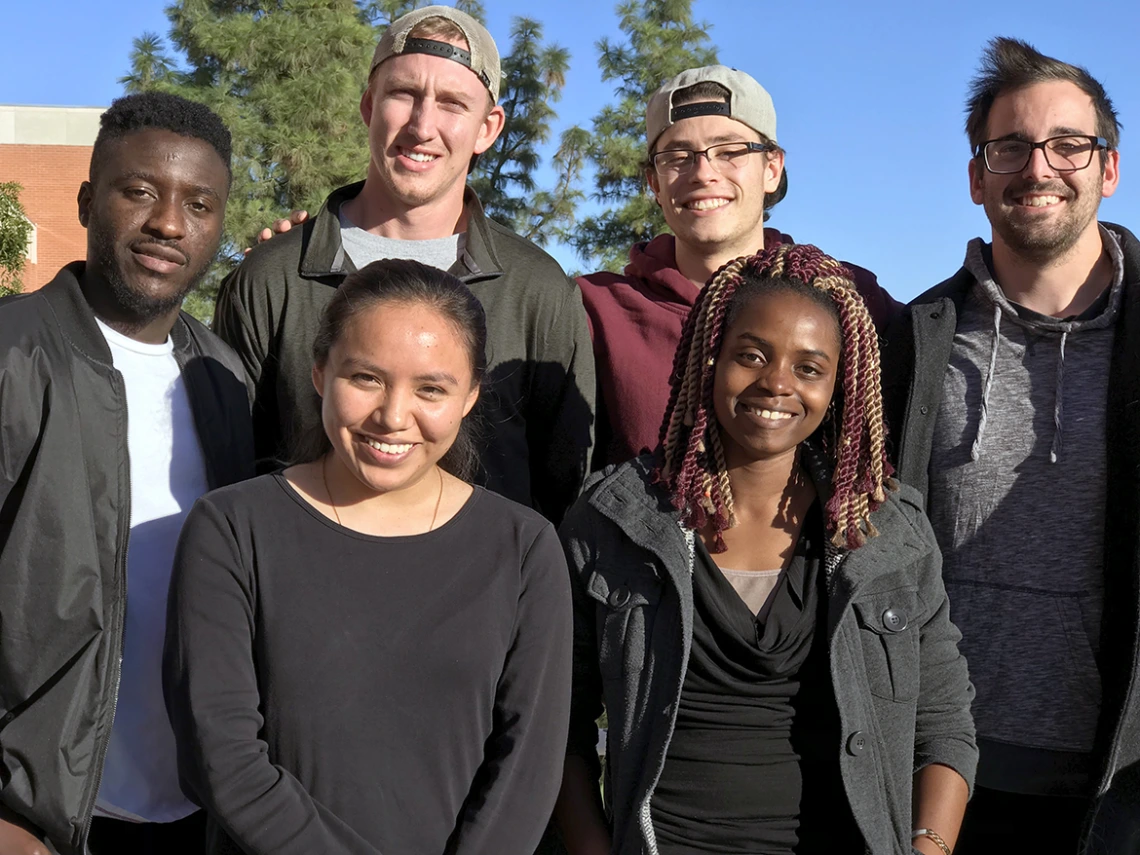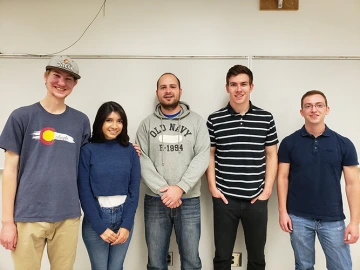New Sponsors Jump On Board for Design Day 2019

The Bayer U.S. Team. Front row, left to right: Veronica Paz, Syntia Bebongchu. Second row, left to right): Hernani Fernandes, Troy Petty, Eric Romero, Joshua Vanderwall
Engineering Design Program newcomers explain what inspired their partnerships.
Organizations that collaborate with the University of Arizona Engineering Design Program consistently report that the program offers them an opportunity to explore projects they might not otherwise be able to pursue, and to dive into the rich talent pool at the UA College of Engineering. This year, several new companies will reap the program’s benefits.
Elbit Systems

The Elbit Systems team. From left to right: Scott Zigray, Danelle Villanueva, Carson Lempa, Keith Durkin, Aaron Silvers
Elbit Systems creates technologies for defense and commercial industries. This year, they’re asking their team of UA engineers to create an eye-safe short-wave infrared illuminator — essentially a flashlight that operates on short- and mid-wave infrared, rather than the longer wavelengths most infrared flashlights operate on.
“Those [long-wave infrared beams] are easily detectable, and can give away the position of the person who’s using it,” said Matthias Whitney, a principal electro-optics engineer at Elbit and the industry mentor for the project. “A lot of newer infrared goggles operate in the short-wave infrared band, so by having illuminations in this wavelength, the flashlight user wearing infrared goggles can see the beam without someone else detecting it.”
Matthias and his wife, Megan Whitney, both graduated from the University of Arizona in 2009, she in mechanical engineering and he in optical sciences. He’s made frequent visits back to the UA as a recruiter, but he encouraged his company to increase its involvement by sponsoring a project.
“If we wish to remain competitive, we need to continually be attracting new talent — such talent as is found at University of Arizona,” Matthias said.
Bayer
Lisa Jones, an engineering site lead at Bayer U.S., is a UA alumna and a former employee of Roche — a longtime partner with the Engineering Design Program. When she started her job at Bayer, one of her priorities was to set the company up with a senior design team.
So, the corporation has tasked a team of engineers with creating a SMART – self-monitoring analytics and reporting technology — watering system to distribute the exact right amount of water to each individual plant in a greenhouse.
Greenhouse plant watering is labor-intensive and often inconsistent, and while some automated watering systems already exist, this one will be uniquely interactive and cloud-based. Humans can monitor the system remotely from a cellphone and track how much water crops receive and any problems the system encounters.
“This is one of the pie-in-the-sky things we have not been able to have in our greenhouse,” Jones said. “We decided to let the students have a go at it, to see what they could come up with.”
TuSimple
TuSimple, a company developing autonomous commercial truck technology, is asking a student team to create an integrated image processing unit for automotive cameras.
Most autonomous or semi-autonomous vehicles today have several cameras that send their video frames to one central computing system, which then processes the images and keeps track of objects around the vehicle. But this powerful central processor is expensive and can cause a single point of failure for all the cameras. Building the processing function into the cameras could mitigate these problems.
TuSimple has worked with the College of Engineering already, collaborating with interim Dean Larry Head, director of the Transportation Research Institute.
“We just enjoy the University of Arizona relationship,” said Robert Brown, director of public affairs at TuSimple. “We have our solution, but we’re curious to see if students will think of something outside the box.”
PayPal
Jot Powers and Greg Vannoni, the industry mentors for PayPal, are both UA alumni. Powers earned a bachelor’s degree in computer engineering in 1993 and Vannoni completed the same in 2006. PayPal is sponsoring a “one-click food bank” project: essentially a software system that will allow food banks to manage inventory, track donations and coordinate volunteer efforts.
The idea for their project came from PayPal’s Opportunity Hack, a weekend-long program that connects nonprofits with students and industry professionals who work together to solve nonprofit tech problems. The concept of creating a system to help food banks run more smoothly has come up often in recent years.
Powers and Vannoni both thought the seniors at their alma mater could deliver, especially after volunteering as judges at Engineering Design Day 2018 and seeing the range of projects.
“We came here because we both have a bias toward engineering, and because we think a solution from a passionate team can help the community,” Powers said.

